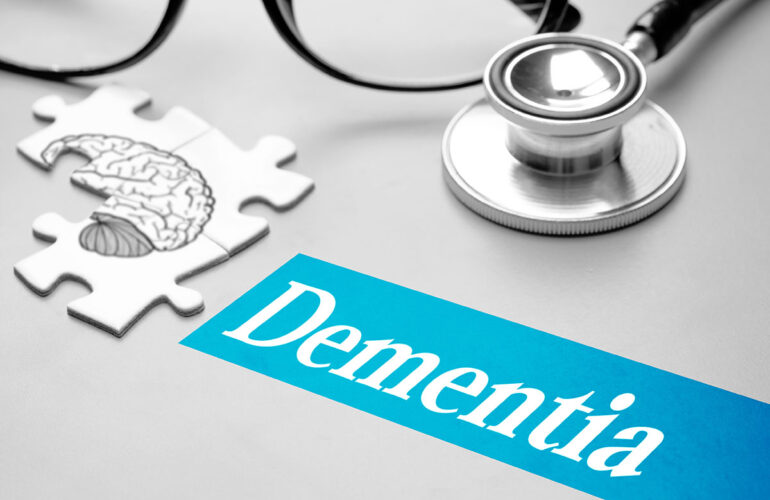It wasn’t that long ago when all forms of cognitive decline were lumped together in loose terms like “Senile Dementia” or “Organic Brain Syndrome”. Each type of dementia now belongs to a group of conditions called “Neurodegenerative Disorders”. Even though research has a long way to go, we are discovering more about various types of dementia, their unique symptoms, patterns of decline and treatments that may help. Here’s a snapshot of the top four most common types of dementia.
Alzheimer’s Disease
By far, Alzheimer’s disease affects more people than any other type of dementia in the United States and around the world. It’s estimated that between 60-80% of all cases of dementia are due to this disease. Often referred to as the “long goodbye”, most people diagnosed with Alzheimer’s will live many years or decades with the illness.
Early Signs of Alzheimer’s
The early signs and symptoms of Alzheimer’s can be unrecognizable and go unnoticed for quite some time. Individuals may show signs like:
- Short term memory loss
- Impaired ability to focus
- Disturbed mood
Once the disease starts to progress, symptoms worsen and the individual will experience:
- Misplacing common items
- Changes in personality
- Inability to recall numbers (telephone numbers and addresses)
- Difficulty planning and solving problems
- Forgetting what was just said or read
- Confusion and disorientation
Alzheimer’s disease then progresses to the point where the individual requires 24/7 care, is unable to walk or engage in activities of daily living, and needs assistance with eating.
Vascular Dementia
This type of dementia accounts for 10% of cases and is quite different from Alzheimer’s disease. injury to the brain is caused by cardiovascular problems like mini strokes that lead to tissue damage and bleeding. While Alzheimer’s is a very slow progression of loss, the signs and symptoms of Vascular Dementia are dramatic and occur immediately following the stroke.
Symptoms of Vascular Dementia
Unlike Alzheimer’s where memory loss is the first sign, once the individual has had a major stroke or a series of mini strokes, certain symptoms will appear including:
- Changes in personality
- Disruption in thinking
- Inability to reason
- Droopy face
- Paralysis
- Body numbness
Depending upon which region of the brain has been affected, other symptoms may arise as well including:
- Inability to pay attention
- Difficulty organizing thoughts
- Inability to analyze situations
- Trouble with speech
- Loss of vision or other senses like smell or taste
- Uncontrollable emotional behavior like laughing or crying
- Uncontrollable body movements like hitting or grabbing
The individual will continue to age with some of these symptoms and may require assistance in activities of daily living.
Frontotemporal Dementia
This form of dementia affects between 2-10% of people with dementia. It is a consequence of deterioration to the Frontal and Temporal Lobes of the brain. Frontotemporal dementia, unfortunately, is often misdiagnosed as Alzheimer’s disease due to some common symptoms including cognitive, emotional and personality changes.
Symptoms of Frontotemporal Dementia
Although Frontotemporal dementia and Alzheimer’s disease share some common characteristics, there are symptoms directly associated with deterioration of the Temporal and Frontal lobes that are exhibited such as:
- Behavioral changes
- Involuntary movement
- Inability to plan, judge or analyze
After a while, the individual may worsen and show the following signs and symptoms:
- Social withdrawal
- Loss of inhibitions
- Shocking behavior
- Loss of interest in others
- Lack of emotions
- Weakened verbal and communication skills
Towards the end of life, the individual may be completely mute, experience major muscle loss, and will be unable to respond to verbal cues. At this stage of the disease, the symptoms of Frontotemporal dementia are very much like those of Alzheimer’s disease.
Lewy Body Dementia
The fourth most common type of dementia affects roughly 5% of people diagnosed. This condition is also known as “Dementia with Lewy Bodies” and is also under- or misdiagnosed just like Frontotemporal Dementia. Some experts describe it as a hybrid disorder mixing symptoms of Parkinson’s disease and Alzheimer’s disease into one condition. Symptoms of Parkinson’s include muscle stiffness and rigidity and those of Alzheimer’s are related to cognitive decline.
Unique Symptoms of Lewy Body Dementia
Unlike the other types of dementia, the primary identifying symptom of Lewy Body dementia is visual hallucinations which are not upsetting or stressful to the individual experiencing them. These typically involve seeing small people, like children, or animals. Sleep walking and acting out dreams are also common, as seen in some cases of Parkinson’s disease.
Final Thoughts on Types of Dementia
While there are other types of dementia including Creutzfeldt-Jakob disease, normal pressure hydrocephalus, Mixed dementia and those associated with Huntington’s disease, Wernicke-Korsakoff Syndrome, and Parkinson’s disease, the four most common are those reviewed in this article. They all share similar characteristics as well as some unique symptoms which clinically set them apart. Each condition is neurodegenerative and will worsen over time. Regardless, we’ve come a long way from simply grouping these conditions into antiquated terms like “Senile dementia” or “Organic Brain Syndrome”. With research and more time, we should know even more information about each disorder and hopefully with such knowledge, discover better treatments or even a cure.

